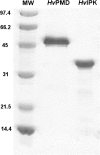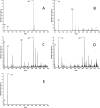Identification in Haloferax volcanii of phosphomevalonate decarboxylase and isopentenyl phosphate kinase as catalysts of the terminal enzyme reactions in an archaeal alternate mevalonate pathway
- PMID: 24375100
- PMCID: PMC3957691
- DOI: 10.1128/JB.01230-13
Identification in Haloferax volcanii of phosphomevalonate decarboxylase and isopentenyl phosphate kinase as catalysts of the terminal enzyme reactions in an archaeal alternate mevalonate pathway
Abstract
Mevalonate (MVA) metabolism provides the isoprenoids used in archaeal lipid biosynthesis. In synthesis of isopentenyl diphosphate, the classical MVA pathway involves decarboxylation of mevalonate diphosphate, while an alternate pathway has been proposed to involve decarboxylation of mevalonate monophosphate. To identify the enzymes responsible for metabolism of mevalonate 5-phosphate to isopentenyl diphosphate in Haloferax volcanii, two open reading frames (HVO_2762 and HVO_1412) were selected for expression and characterization. Characterization of these proteins indicated that one enzyme is an isopentenyl phosphate kinase that forms isopentenyl diphosphate (in a reaction analogous to that of Methanococcus jannaschii MJ0044). The second enzyme exhibits a decarboxylase activity that has never been directly attributed to this protein or any homologous protein. It catalyzes the synthesis of isopentenyl phosphate from mevalonate monophosphate, a reaction that has been proposed but never demonstrated by direct experimental proof, which is provided in this account. This enzyme, phosphomevalonate decarboxylase (PMD), exhibits strong inhibition by 6-fluoromevalonate monophosphate but negligible inhibition by 6-fluoromevalonate diphosphate (a potent inhibitor of the classical mevalonate pathway), reinforcing its selectivity for monophosphorylated ligands. Inhibition by the fluorinated analog also suggests that the PMD utilizes a reaction mechanism similar to that demonstrated for the classical MVA pathway decarboxylase. These observations represent the first experimental demonstration in H. volcanii of both the phosphomevalonate decarboxylase and isopentenyl phosphate kinase reactions that are required for an alternate mevalonate pathway in an archaeon. These results also represent, to our knowledge, the first identification and characterization of any phosphomevalonate decarboxylase.
Figures






References
MeSH terms
Substances
LinkOut - more resources
Full Text Sources
Other Literature Sources
Molecular Biology Databases

